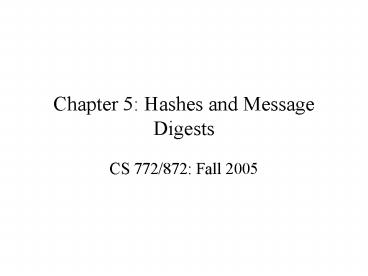Chapter 5: Hashes and Message Digests - PowerPoint PPT Presentation
1 / 18
Title:
Chapter 5: Hashes and Message Digests
Description:
A hash or message digest, is a one-way function since it is not practical to reverse. ... Let n be the number of persons and k be the number of birth dates (k = 365) ... – PowerPoint PPT presentation
Number of Views:552
Avg rating:3.0/5.0
Title: Chapter 5: Hashes and Message Digests
1
Chapter 5 Hashes and Message Digests
- CS 772/872 Fall 2005
2
- A hash or message digest, is a one-way function
since it is not practical to reverse. - A function is cryptographicaly secure if it is
computationally infeasible to find - a message that has a given message digest.
- a different message with the same message
digest. - two messages that have the same message digest.
3
Major Algorithms
- Ron Rivest Message Digest MD-family (MD2, MD4 and
MD5) 128-bit - NIST Secure Hash Algorithm SHA-1 160-bit.
- They take an arbitrary-length string and map it
to a fixed-length quantity that appears to be
randomly chosen. For example, two inputs that
differ by only one bit should have outputs that
look like completely independently chosen random
numbers.
4
The Birthday Problem
- What is the minimum number of persons in a room
so that the odds are better than 50 that two of
them will have the same birthday? 23 persons. - Why? Let n be the number of persons and k be the
number of birth dates (k 365). There are P
n(n-1)/2 pairs of persons. The probability that
a give pair have the same birth date is 1/k.
Therefore we need at least k/2 pairs for 50
probability to find a match since - 1/k 1/k ... 1/k P (1/k) gt 1/2 P gt k/2
n(n-1)/2 gt k/2 n(n-1) gt k n2 gt k or n sqrt
(k) In general if the message digest is m bits
then k2m and we need to examine at least 2m/2
messages before we could find two message with
the same digest. e.g., if m 128 we need 264
messages.
5
Things to do with a Hash
- Authentication
- Computing a MAC
- Encryption
- Using Secret Key for a Hash
6
Authentication
- Alice authenticating Bob
- Alice Bob
- challenge r gtgtgtgtgtgtgt r
- response d ltltltltltltlt dMDKr
- r is a random number, - MDKr is
the message digest of K concatenated with r.
Alice computes MDKr and if equal d,
then Bob must know K.
7
Computing a MAC
- Using Secret Key K between Alice and Bob
- Alice sends Bob receives
m,d gtgtgtgtgtgtgtgtgtgt m,d , OK if d MD
(Km) - where d MD(Km)
- K is the shared secret between Alice and Bob
- This works except for some idiosyncrasies of most
MD algorithms have the following property - if dMD(x) d'MD(xy), then d'dMD(y)
- Thus an attacker may intercepts ltm,dgt and replace
it with ltm',d'gt, where m'my and d'dMD(y).
Bob receives ltm',d'gt and will find out d'
MD(Km'). - How to avoid this flow?
- Compute MD(mK) instead of MD(Km).
- Compute MD(KmK)
- Compute MD(KMD(Km))
8
Encryption
- Generating one-time pad
- Both Alice and Bob know the shared
secret K and generate - b1 MD(K) bi
MD(Kbi-1), i2,3, .... - Alice sends Bob receives
ci mi bi gtgt ci and
computes - mi
ci bi
9
Using Secret Key for a Hash
- Unix Password Hash
- Unix uses DES' to compute the hash of a
password, which it then stores. (it uses a
modified DES to prevent DES hardware from
cracking Unix passwords). - - DES secret Key Pack the 7-bit
ASCII associated with each of the first 8
characters of the password into 56-bit DES key.
- Salt A 12-bit random
number (salt) is stored with the hashed password
(to prevent dictionary attack). The
salt is used to modify the DES data expansion
algorithm (expand R from 32 to 48 bits).
- Hashed password The modified DES
is used with the secret key to encrypt the
constant 0. The result is stored with
the salt as the user's hashed password.
10
MD2
- It takes a message of arbitrary length and
produces 128-bit message digest. - Padding
- The message must be multiple of 16 octets. If
the message is already multiple of 16 octets, 16
octets of padding are added, otherwise r octets
(1lt r lt15) are added. Each pad octet contains
the value r. Note that there must always be
padding. - Example consider a message m
"abcdefghij" of 10 bytes, the value of r
is 6 and the message is padded as follows
"abcdefghij666666". - Checksum Figure 5-4
- A 16-byte checksum is appended to the message
before computing the MD.
11
(No Transcript)
12
(No Transcript)
13
(No Transcript)
14
MD4
- Was designed to be a 32-bit word oriented so it
can be computed faster on 32-bit CPUs rather
than an octet-oriented MD2.
15
MD5
- Was designed to be more concerned with security
than speed. - All the MD family algorithms produce 128-bit
digests.
16
SHA-1
- Designed by NIST to produce 160-bit digests (it
is more secure than MD5 but little slower).
17
HMAC (hash-based MAC)
- HMAC prepends the key to the data, digests it,
and then prepends the key to the result and
digests that. It takes a variable-length key and
a variable-sized message and produces a
fixed-size output that is the same size as the
underlying digest algorithm. The key is padded
with 0s to 512 bits.
18
(No Transcript)































